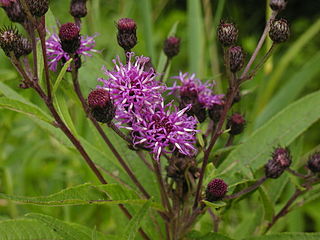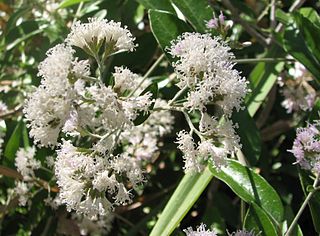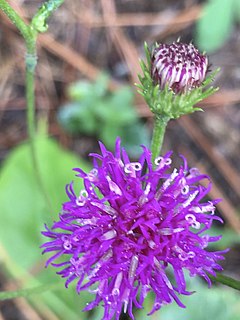
Vernonia is a genus of about 350 species of forbs and shrubs in the family Asteraceae. Some species are known as ironweed. Some species are edible and of economic value. They are known for having intense purple flowers. The genus is named for the English botanist William Vernon. There have been numerous distinct subgenera and subsections named in this genus, and some botanists have divided the genus into several distinct genera. For instance, the Flora of North America recognizes only about twenty species in Vernoniasensu stricto, seventeen of which are in North America north of Mexico, with the others being found in South America.

Vernonia galamensis is a plant in the sunflower family, known for its use as an oilseed. This species, often called ironweed, is the largest source of vernonia oil, which is rich in a useful epoxy fatty acid called vernolic acid and is used to make plastics, rubbery coatings, and drying agents. Use of this oil as a replacement for traditional plasticizers and binders in the production of paints and PVC shows promise as a method of reducing smog pollution.

Vernolic acid (leukotoxin) is a long chain fatty acid that is monounsaturated and contains an epoxide. It is the R,R-cis epoxide derived from the C12–C13 alkene of linoleic acid. Vernolic acid was first definitively characterized in 1954. It is a major component in vernonia oil, which is produced in abundance by the genera Vernonia and Euphorbia and is a potentially useful biofeedstock.
Leucomeris is a genus of Asian flowering plant in the sunflower family.
Brimeura duvigneaudii is a species of plant that is endemic to Spain. Its natural habitats are Mediterranean matorral shrubland, and above rocky shores.

Vernonia noveboracensis is a plant in the daisy family, Asteraceae. It is native to the eastern United States, from Florida to Massachusetts and west to Tennessee, Alabama, and West Virginia and to southern Ontario.

Vernonieae is a tribe of about 1300 species of plants in the aster family. They are mostly found in the tropics and warmer temperate areas, both in the Americas and the Old World. They are mostly herbaceous plants or shrubs, although there is at least one tree species, Vernonia arborea.

Vernonia amygdalina, a member of the daisy family, is a small shrub that grows in tropical Africa. V. amygdalina typically grows to a height of 2–5 m (6.6–16.4 ft). The leaves are elliptical and up to 20 cm (7.9 in) long. Its bark is rough. V. amygdalina is commonly called Congo Bololo in D. R. Congo, bitter leaf in English because of its bitter taste. African common names include grawa (Amharic), ewuro (Yoruba), etidot (Efik), onugbu (Igbo), ityuna (Tiv), oriwo (Edo), Awɔnwono (Akan), chusar-doki or shuwaka (Hausa), mululuza (Luganda), labwori (Acholi), olusia (Luo), ndoleh (Cameroon) and olubirizi (Lusoga).
Vernonia blodgettii, the Florida ironweed or Blodgett's ironweed, is a species of perennial plant from family Asteraceae that is native to Florida and the Bahamas.

Vernonia gigantea is a species of perennial plant from family Asteraceae found in United States and Canada. The plant is native to the eastern United States, north to New York state and Ontario, and southwest to Texas.

Vernonia missurica, the Missouri ironweed, is a species of purple-flowered perennial plant from family Asteraceae found growing in the central United States.

Vernonia arkansana is a species of perennial plant from family Asteraceae found in south-central United States. The plant is 4–6 feet (1.2–1.8 m) high and 3–4 feet (0.91–1.22 m) wide. The flowers bloom from August to September and are pink-purple coloured. It is a recipient of the Royal Horticultural Society's Award of Garden Merit.

Tarlmounia is a plant genus in the family Asteraceae. The sole species is Tarlmounia elliptica, native to India, Burma and Thailand and naturalised in southern Taiwan and Queensland, Australia. Common names include curtain creeper, vernonia creeper and parda bel.

Vernonia baldwinii, the western ironweed or Baldwin's ironweed, is a perennial herb native to central North America.

Vernonia lindheimeri, commonly known as woolly ironweed, is a species of flowering plant in the aster family (Asteraceae). It is native North America, where it is native to the state of Coahuila in Mexico and to the state of Texas in the United States. Its natural habitat is in open, calcareous areas.

Vernonia texana, commonly called Texas ironweed, is a species of flowering plant in the aster family (Asteraceae). It is native eastern to North America, where it is found primarily in the South Central region of the United States. Its natural habitat is in open sandy woodlands.

Vernonia acaulis is a species of perennial plant from family Asteraceae. It is native to the U.S.A.

Vernonia angustifolia is a species of flowering plant in the family Asteraceae, native to the southeastern United States. It was first described by André Michaux in 1803.














